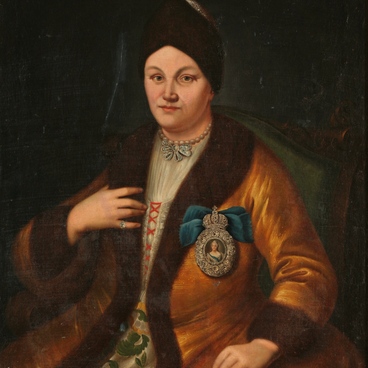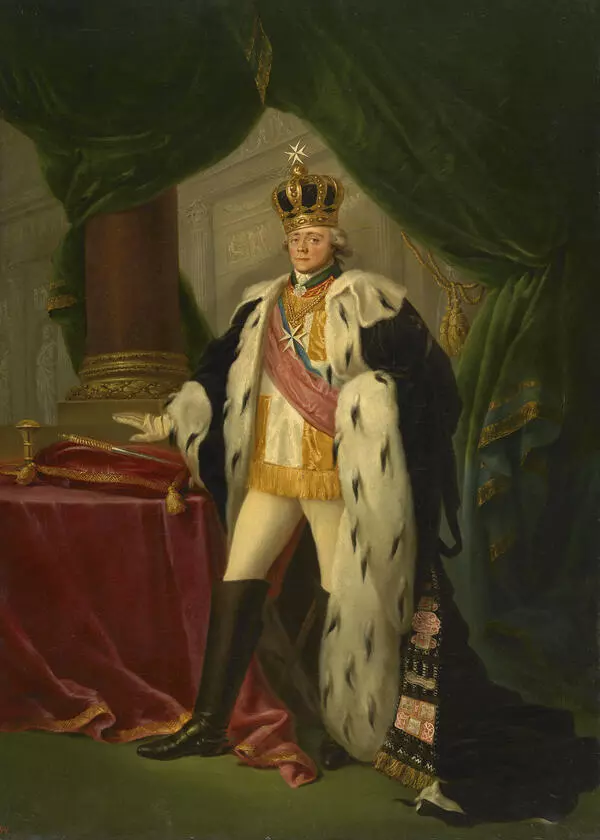This portrait is one of the most beautiful in the museum’s collection, it is also from the family gallery of the Counts Uvarov. Polish Princess Maria Antonovna Chetvertinskaya (1779-1854) found herself at the Russian court after the death of her father A.-S. Svyatopolk-Chetvertinsky during the Polish uprising. At the age of sixteen, she was married to the 37-year-old chief chamberlain Dmitry Lvovich Naryshkin, one of the richest nobles of the Catherine era. The beauty of the young lady-in-waiting was praised by contemporaries, “it seemed impossible, unnatural.” The dazzling beauty of Princess Maria Antonovna, her ability to keep herself in polite society attracted the attention of then Tsarevich Alexander Pavlovich, the future Emperor Alexander I. Their relationship lasted for fifteen years. Her official husband was very condescending to such a situation, and allowed liberties to himself.
A number of her portraits in her youth are known, but the portrait by Salvator (Nikolai Ivanovich) Tonchi (1756-1844), presented in the Pavlovsk Museum, is more popular than others. It is interesting to compare it with the Murom version of the same portrait: the master painting, the finest manner, no signature on both. There are reasons to consider one of the portraits an author’s replication. The staff of the Pavlovsk Palace Museum agreed with this opinion. It can be noted that a close assessment of the canvases allows us to note a slightly higher level of painting of the Murom portrait. The provenance is very reliable — the portrait comes from the estate in Karacharov, the last owner of which, Countess P. S. Uvarova, was Naryshkin’s grand-niece. Uvarova’s grandfather, the beauty’s brother Boris Chetvertinsky suffered greatly from the ambiguity of his sister’s position and even resigned several times.
The portrait is very concise and expressive. The background is impenetrably dark. In the center, a lady is highlighted in an elegant U-turn. Her outfit is ephemeral. The dresses of that era are a continuation of the early Empire of the 1790s, they were sewn from muslin, cambric and silk. Women usually didn’t wear corsets, and if they wore them, they did not tighten them as much as in previous and subsequent times. The colors of the dresses are mostly pastel. To match the fashion, ladies wore light dresses in winter, which often caused them to catch a cold.
A number of her portraits in her youth are known, but the portrait by Salvator (Nikolai Ivanovich) Tonchi (1756-1844), presented in the Pavlovsk Museum, is more popular than others. It is interesting to compare it with the Murom version of the same portrait: the master painting, the finest manner, no signature on both. There are reasons to consider one of the portraits an author’s replication. The staff of the Pavlovsk Palace Museum agreed with this opinion. It can be noted that a close assessment of the canvases allows us to note a slightly higher level of painting of the Murom portrait. The provenance is very reliable — the portrait comes from the estate in Karacharov, the last owner of which, Countess P. S. Uvarova, was Naryshkin’s grand-niece. Uvarova’s grandfather, the beauty’s brother Boris Chetvertinsky suffered greatly from the ambiguity of his sister’s position and even resigned several times.
The portrait is very concise and expressive. The background is impenetrably dark. In the center, a lady is highlighted in an elegant U-turn. Her outfit is ephemeral. The dresses of that era are a continuation of the early Empire of the 1790s, they were sewn from muslin, cambric and silk. Women usually didn’t wear corsets, and if they wore them, they did not tighten them as much as in previous and subsequent times. The colors of the dresses are mostly pastel. To match the fashion, ladies wore light dresses in winter, which often caused them to catch a cold.




